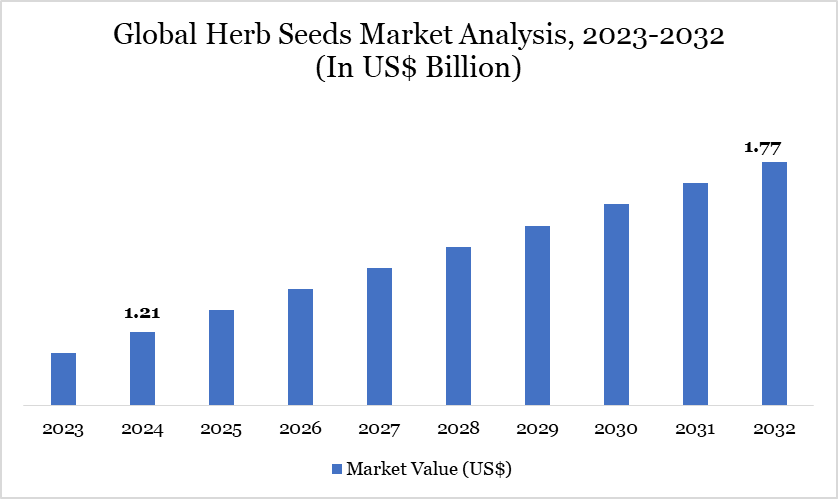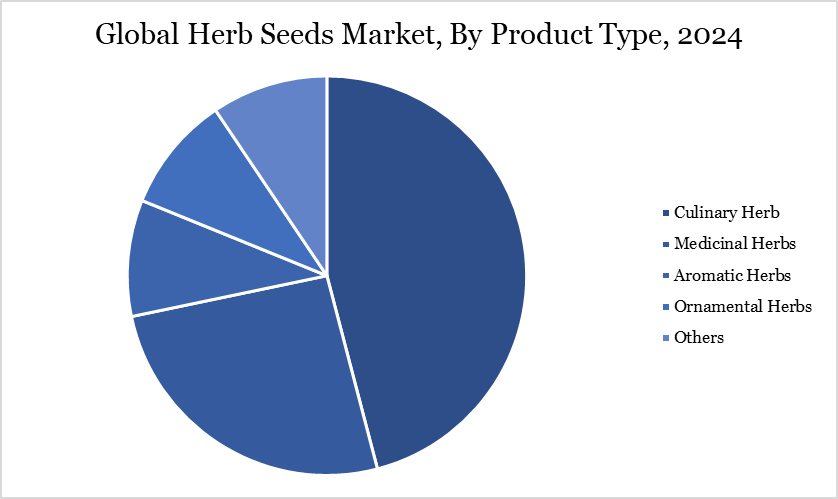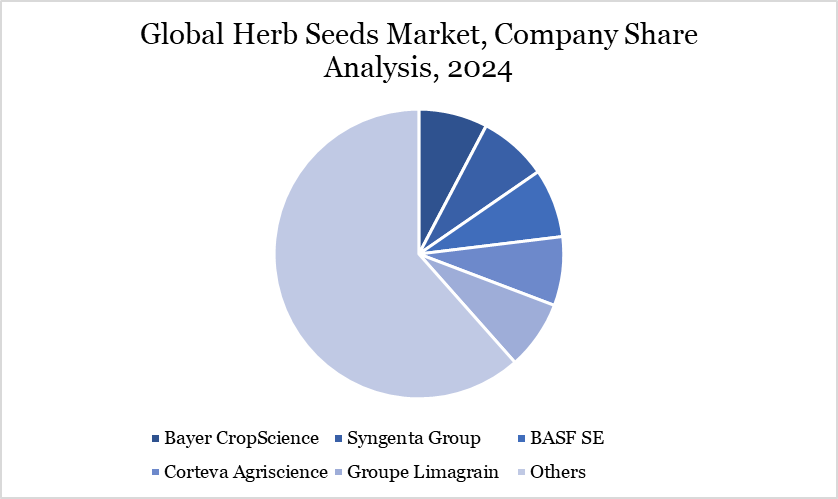Herb Seeds Market Size
Herb Seeds Market size reached US$ 1.21 billion in 2024 and is expected to reach US$ 1.77 billion by 2032, growing with a CAGR of 4.89% during the forecast period 2025-2032.
The herb seeds market is experiencing significant growth, propelled by government initiatives and research advancements. In India, the CSIR-Central Institute of Medicinal and Aromatic Plants (CIMAP) developed 'CIM-Rhoi Gold' in 2024, a high-yielding variety of the endangered Ayurvedic herb Prishniparni, enhancing both conservation and cultivation efforts.
China's Ministry of Agriculture and Rural Affairs, in 2025, certified 35 seed varieties, including herbs, to improve seed quality and agricultural productivity. In Vietnam, the government approved a project in 2025 to develop Quang Nam Province into a medicinal herb industry hub, focusing on Ngọc Linh ginseng, aiming to establish a comprehensive supply chain from seed production to distribution.
Herb Seeds Market Trend
The herb seeds market is witnessing dynamic shifts in 2024–2025, marked by significant government-led initiatives and advancements in seed quality and cultivation practices. In China, the Ministry of Agriculture and Rural Affairs certified 35 seed varieties in March 2025, enhancing seed quality and boosting crop yields. Vietnam's Kon Tum province aims to plant over 1,500 hectares of Ngọc Linh ginseng in 2025, with businesses planning to propagate more than 15.2 million seedlings.
Additionally, the Vietnamese government approved a project in March 2025 to establish a medicinal herb industry hub in Quảng Nam province, focusing on Ngọc Linh ginseng as a key crop. These developments underscore a regional emphasis on enhancing herb seed quality, expanding cultivation areas, and integrating comprehensive supply chains to meet both domestic and international demand.

For more details on this report, Request for Sample
Market Scope
| Metrics | Details |
| By Seed Type | Open-Pollinated Seeds, Hybrid Seeds, Genetically Modified (GM) |
| By Herb Type | Culinary Herb, Medicinal Herbs, Aromatic Herbs, Ornamental Herbs, Others |
| By Cultivation Method | Traditional Outdoor Cultivation, Greenhouse Cultivation, Hydroponic Cultivation, Vertical Farming |
| By Distribution Channel | Supermarkets/Hypermarket, Specialty Stores, Online Retail, Others |
| By Region | North America, South America, Europe, Asia-Pacific and Middle East and Africa |
| Report Insights Covered | Competitive Landscape Analysis, Company Profile Analysis, Market Size, Share, Growth |
Herb Seeds Market Dynamics
Expansion of Urban and Vertical Gardening Practices
The expansion of urban and vertical gardening practices is a significant driver of the global herb seeds market. As urbanization increases and green spaces become scarce, innovative gardening methods such as urban and vertical gardening are gaining popularity. These practices offer efficient ways to cultivate herbs in limited spaces, driving the demand for herb seeds.
Urban gardening has become a crucial trend in cities worldwide as urban populations grow and green spaces diminish. This form of gardening involves growing plants within urban environments, including rooftops, balconies, community gardens, and other small spaces. The United Nations reports that by 2050, 68% of the world's population is expected to live in urban areas. This demographic shift necessitates creative solutions for food production, including the cultivation of herbs.
Supply Chain Disruptions and Logistics Challenges
Supply chain disruptions and logistics challenges have emerged as significant restraints on the global herb seeds market. These issues affect the availability, pricing, and timely delivery of herb seeds, impacting both producers and consumers. According to a report by the United Nations Conference on Trade and Development (UNCTAD), global trade contracted by approximately 9% in 2020 due to the pandemic. The agricultural sector, including seed distribution, was particularly affected, leading to shortages and increased prices for herb seeds.
Transportation and logistics challenges are critical issues for the herb seeds market. The complexity of moving seeds across regions and countries involves several steps, including packaging, storage, and transportation. Any disruption at any point in this chain can lead to significant delays and losses. For instance, container shortages and port congestion have become prominent issues, exacerbated by the pandemic and increased global demand for shipping services.
Herb Seeds Market Segment Analysis
The global herb seeds market is segmented based on seed type, herb type, cultivation method, distribution channel and region.

Culinary Herb Segment Driving Herb Seeds Market
The culinary herb segment is a significant driver of the herb seeds market, propelled by governmental initiatives and consumer demand for diverse, health-oriented diets. In India, the National Seeds Corporation Limited (NSC), a government undertaking, produces approximately 150,000 tons of seeds annually, including a variety of culinary herbs such as coriander and fenugreek, to support the nation's agricultural needs.
China has expanded its herbal cultivation area from 400,000 hectares in the 1950s to over 9.3 million hectares, with more than 200 herbs, including culinary varieties, now cultivated to meet both domestic and international demand. Vietnam's Ministry of Agriculture and Rural Development has implemented the Green Growth Action Plan, aiming to develop sustainable agriculture practices, which include the cultivation of herbs like Ngọc Linh ginseng, thereby boosting the herb seeds market. These concerted efforts across Asia-Pacific underscore the pivotal role of the culinary herb segment in advancing the herb seeds market.
Herb Seeds Market Geographical Share
Demand for Herb Seeds in Asia-Pacific
The demand for herb seeds in the Asia-Pacific region is experiencing strong growth, driven by government-backed agricultural reforms and rising consumer interest in health-focused diets. In India, the Ministry of Agriculture & Farmers Welfare reported that under the Seed Village Program, over 60,000 villages were engaged in quality seed production including herbs like coriander, fennel, and basil by 2023.
China’s Ministry of Agriculture and Rural Affairs has promoted the expansion of herbal seed cultivation under its Traditional Chinese Medicine (TCM) modernization plans, increasing herb farming areas in provinces like Yunnan and Sichuan. Similarly, Vietnam’s Ministry of Agriculture is supporting herb seed development through agroecological zoning and organic certification efforts under its national Green Growth Strategy. These policy measures, combined with growing regional demand for culinary and medicinal herbs, are contributing to a notable rise in herb seed adoption across Asia-Pacific, particularly for species suited to local agro-climatic conditions.
Sustainability Analysis
The sustainability profile of the herb seeds market is increasingly shaped by government-led initiatives and corporate commitments toward regenerative agriculture and biodiversity conservation. According to the USDA’s 2023 Organic Survey, herb seed production in the US under certified organic systems grew by 12% from 2019, reflecting rising demand for sustainably sourced seeds.
The EU’s Farm to Fork Strategy targets at least 25% of EU agricultural land to be under organic farming by 2030, directly boosting demand for organic herb seeds like basil, thyme, and oregano. In India, the National Medicinal Plants Board (NMPB) under the Ministry of AYUSH supported the cultivation of over 140,000 hectares of medicinal and herbal crops by 2022, emphasizing seed sustainability through community nurseries and certified seed programs.
Corporations such as Rijk Zwaan and Bejo Seeds report transitioning over 40% of their herb seed production to climate-resilient practices like drip-irrigated seed farms and low-carbon seed drying technologies, aligning with Scope 3 emissions targets. These efforts collectively underscore a clear market shift toward traceable, eco-certified herb seeds as sustainable agriculture becomes a regulatory and commercial priority.
Herb Seeds Market Major Players
The major global players in the market include Bayer CropScience, Syngenta Group, BASF SE, Corteva Agriscience, Groupe Limagrain, Sakata Seed Corporation, Enza Zaden, Rijk Zwaan, Takii & Co. Ltd., and Bejo Zaden B.V.

Key Developments
In January 2025, Kian Capital Partners, a lower-middle-herb seed market-focused private investment firm, announced that in partnership with management, it completed the acquisition of Eden Brothers, a high-growth e-commerce retailer specializing in flower seeds and bulbs for gardening enthusiasts nationwide.
Why Choose DataM?
Data-Driven Insights: Dive into detailed analyses with granular insights such as pricing, market shares and value chain evaluations, enriched by interviews with industry leaders and disruptors.
Post-Purchase Support and Expert Analyst Consultations: As a valued client, gain direct access to our expert analysts for personalized advice and strategic guidance, tailored to your specific needs and challenges.
White Papers and Case Studies: Benefit quarterly from our in-depth studies related to your purchased titles, tailored to refine your operational and marketing strategies for maximum impact.
Annual Updates on Purchased Reports: As an existing customer, enjoy the privilege of annual updates to your reports, ensuring you stay abreast of the latest market insights and technological advancements. Terms and conditions apply.
Specialized Focus on Emerging Markets: DataM differentiates itself by delivering in-depth, specialized insights specifically for emerging markets, rather than offering generalized geographic overviews. This approach equips our clients with a nuanced understanding and actionable intelligence that are essential for navigating and succeeding in high-growth regions.
Value of DataM Reports: Our reports offer specialized insights tailored to the latest trends and specific business inquiries. This personalized approach provides a deeper, strategic perspective, ensuring you receive the precise information necessary to make informed decisions. These insights complement and go beyond what is typically available in generic databases.
Target Audience 2024
Manufacturers/ Buyers
Industry Investors/Investment Bankers
Research Professionals
Emerging Companies